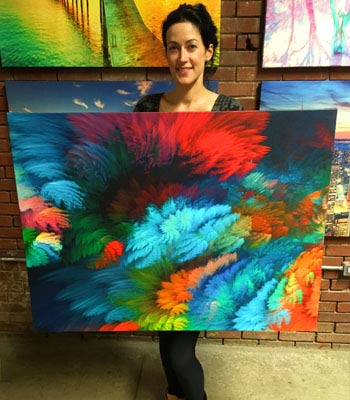When it comes to translating digital designs onto physical canvas, two prominent methods stand out: canvas printing on HP printers with pigment ink and the traditional technique of screen printing. In this article, we’ll delve deeper into the production processes and the impact on artistic expression for both methods.
Canvas Printing on HP Printers with Pigment Ink: Production Process and Artistic Expression
Canvas printing on HP printers with pigment ink leverages cutting-edge digital printing technology to reproduce images with exceptional accuracy and vibrancy on canvas material.
Production Process:
- Image Preparation: Digital images are prepared using graphic design software, allowing for precise color adjustments and detailing.
- Printing: The prepared image is printed directly onto the canvas using an HP printer equipped with pigment inks. The ink droplets are precisely placed to recreate the design.
- Drying: Pigment inks are generally quick-drying, reducing the waiting time between printing and handling.
- Finishing: Once the print is dry, it may be coated with a protective layer to enhance durability, UV resistance, and color longevity.
- Stretching and Framing: The printed canvas can be stretched over wooden frames to create a gallery-wrap effect, enhancing the aesthetic appeal of the artwork.
Artistic Expression:
- Color Accuracy: HP printers with pigment ink excel in reproducing accurate and vibrant colors, allowing artists to faithfully translate their digital visions onto canvas.
- Detail and Resolution: High-resolution printing ensures that even intricate details are captured, contributing to the overall quality of the artwork.
- Longevity: Pigment inks are known for their resistance to fading and environmental factors, ensuring that the artwork retains its brilliance over time.
- Individual Prints: Canvas printing is suitable for producing individual or limited-edition prints, making it an ideal choice for artists seeking to showcase their unique creations.
Screen Printing: Production Process and Artistic Expression
Screen printing, a traditional method with a tactile quality, involves manually transferring ink through a mesh screen onto canvas.
Production Process:
- Stencil Creation: A stencil is created on a mesh screen, where the design is divided into separate color layers. Each layer corresponds to a different screen.
- Ink Application: Ink is applied onto the screen and forced through the mesh onto the canvas using a squeegee. A separate screen is used for each color layer.
- Drying: The canvas is allowed to dry between each color layer application to prevent smudging and color mixing.
- Layering: The layering of colors and textures can create a unique tactile quality, adding depth to the artwork.
- Finishing: Similar to canvas printing, screen-printed canvas can also be stretched, framed, and coated for protection.
Artistic Expression:
- Texture and Depth: Screen printing’s manual application of ink creates a texture and depth that is not easily achievable through digital printing.
- Limited Color Palette: Due to the manual nature of screen printing, achieving a wide color range and intricate color gradients can be challenging.
- Bulk Production: Screen printing is advantageous for bulk production of the same design, making it a preferred choice for merchandise or promotional items.
- Artisanal Appeal: The handcrafted nature of screen printing adds an artisanal quality to the artwork, appealing to those who value tactile experiences.
Conclusion
Canvas printing on HP printers with pigment ink and screen printing both offer unique advantages and artistic possibilities. Canvas printing excels in color accuracy, detail, and longevity, making it suitable for artists who prioritize faithful reproduction and individual prints. Screen printing, with its tactile texture and artisanal charm, appeals to those seeking a hands-on approach and are willing to embrace a limited color palette. The choice between these methods depends on an artist’s priorities, project scope, and desired artistic expression. Whether embracing the precision of digital printing or the tactile artistry of screen printing, both techniques offer opportunities for creativity and visual impact.
